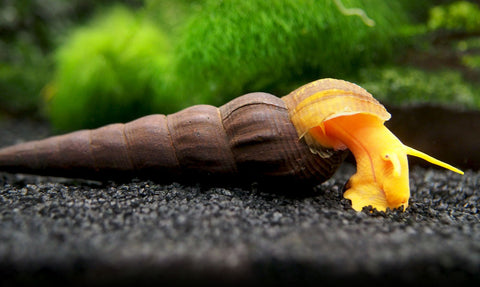Our Invert Obsession: Orange Giant Sulawesi Rabbit Snail (Tylomelania gemmifera)

the World of Orange Giant Sulawesi Rabbit Snails: A Journey for the Invert Obsessed
Get ready to dive deep into the fascinating world of the Orange Giant Sulawesi Rabbit Snail, scientifically known as Tylomelania gemmifera. As true Invert Obsessed individuals, we're thrilled to introduce you to this unique freshwater invertebrate, renowned for its striking appearance and captivating behaviors. Join us on this adventure as we unravel the allure of these extraordinary snails and share our passion for these amazing creatures!
Introducing the Orange Giant Sulawesi Rabbit Snail
A Closer Look at Tylomelania gemmifera
The Orange Giant Sulawesi Rabbit Snail, scientifically known as Tylomelania gemmifera, is a captivating species native to the freshwater rivers and streams of Sulawesi, an island in Indonesia. Endemic to this region, these snails are intricately woven into the ecosystem, playing vital roles in nutrient cycling and maintaining ecological balance. Found amidst the lush vegetation and crystal-clear waters of Sulawesi's aquatic habitats, they have adapted to thrive in diverse environmental conditions, showcasing their resilience and adaptability. Renowned for its vibrant orange coloration and distinctive spiral shell, this remarkable snail species has garnered global attention as a prized addition to freshwater aquariums
Characteristics and Habitat
Striking Appearance
The Orange Giant Sulawesi Rabbit Snail boasts a large, elongated shell adorned with intricate spirals and ridges. Its vibrant orange hue adds a splash of color to any aquarium, creating a visually stunning focal point.

Unique Shell Patterns: Each snail's shell possesses a distinctive pattern, making them truly unique. Some individuals may have intricate swirls, while others display bold stripes or speckles.
Unique Behaviors
Unlike typical snails, Tylomelania gemmifera is relatively active and can often be seen exploring its surroundings. It is known for its gentle grazing behavior, as it feeds on algae and detritus, helping to keep the aquarium clean and balanced.

Shell Growth: As they age, Orange Giant Sulawesi Rabbit Snails continuously add layers to their shells, resulting in noticeable growth rings that can indicate their age and health status.
Ideal Tank Conditions
To thrive, Orange Giant Sulawesi Rabbit Snails require a well-maintained aquarium with stable water parameters. They prefer slightly alkaline water with a pH range of 7.5 to 8.5 and a temperature between 76°F to 84°F. Providing ample hiding spots and vegetation will ensure that these snails feel safe and secure in their environment.

Environmental Indicators: Due to their sensitivity to water quality, these snails serve as excellent indicators of aquarium health. Changes in behavior or shell condition can alert hobbyists to potential issues within the tank.
Care and Maintenance
Tank Setup
When setting up a tank for Orange Giant Sulawesi Rabbit Snails, it's essential to include plenty of hiding places, such as caves, rocks, and driftwood. These snails are nocturnal and prefer to retreat to sheltered areas during the day.
Feeding
Orange Giant Sulawesi Rabbit Snails are omnivores and will consume a variety of foods, including algae wafers, blanched vegetables, and sinking pellets. It's crucial to provide a balanced diet to ensure their health and vitality.
Compatibility
These snails are generally peaceful and can coexist with a wide range of tank mates, including fish and other invertebrates. However, it's essential to avoid aggressive or predatory species that may harm or harass them.
Breeding
Reproductive Behavior
Orange Giant Sulawesi Rabbit Snails and Golden Rabbit Snails, both prized additions to freshwater aquariums, exhibit fascinating breeding behaviors in captivity. While Orange Giant Sulawesi Rabbit Snails are capable of breeding under the right conditions, with females laying eggs on hard surfaces within the aquarium, resulting in the hatching of tiny juvenile snails after a few weeks, Golden Rabbit Snails offer a different breeding experience. Relatively easy to breed, Golden Rabbit Snails are hermaphrodites, possessing both male and female reproductive organs. As such, they do not require a partner for reproduction. These snails lay their eggs above the waterline, emphasizing the importance of providing a suitable space for egg-laying within the aquarium setup.

Mating Rituals: When breeding, Orange Giant Sulawesi Rabbit Snails engage in fascinating courtship displays, including elaborate movements and tactile interactions, to ensure successful reproduction.
Rearing Juveniles
Rearing juvenile snails can be a rewarding experience for dedicated hobbyists. Providing ample food and maintaining optimal water conditions will ensure the healthy growth and development of the young snails.
Ideal Tank Mates for Orange Giant Sulawesi Rabbit Snails
Orange Giant Sulawesi Rabbit Snails are peaceful creatures that thrive in community aquariums. Here are some ideal tank mates that can coexist harmoniously with these snails:
Small Fish Species: Peaceful and non-aggressive fish species like neon tetras, guppies, and rasboras make excellent companions for Orange Giant Sulawesi Rabbit Snails.
Other Invertebrates: Compatible invertebrates such as dwarf shrimp, nerite snails, and Malaysian trumpet snails can share the tank with these snails without any issues.
Bottom Dwellers: Bottom-dwelling fish like Corydoras catfish and small loaches are suitable tank mates as they inhabit different areas of the aquarium and pose no threat to the snails.
Non-Ideal Tank Mates for Orange Giant Sulawesi Rabbit Snails
While Orange Giant Sulawesi Rabbit Snails are generally peaceful, certain tank mates may not be suitable due to their behavior or dietary preferences. Here are some examples:
Aggressive Fish Species: Avoid keeping aggressive fish such as cichlids, bettas, or larger predatory fish with Orange Giant Sulawesi Rabbit Snails, as they may harass or even prey upon the snails.
Crustaceans with Predatory Behavior: Crayfish and larger shrimp species with predatory tendencies may view Orange Giant Sulawesi Rabbit Snails as potential prey, leading to aggression or harm.
Bottom-Dwelling Aggressors: Some bottom-dwelling fish like territorial plecos or aggressive catfish species may compete with Orange Giant Sulawesi Rabbit Snails for food and territory, leading to stress or conflict.
By carefully selecting compatible tank mates and avoiding aggressive or predatory species, you can create a harmonious and thriving aquarium environment for Orange Giant Sulawesi Rabbit Snails.
Conclusion
The Orange Giant Sulawesi Rabbit Snail is truly a marvel of the freshwater aquarium hobby, with its striking appearance and engaging behaviors. Whether you're a seasoned enthusiast or a newcomer to the hobby, adding these captivating snails to your tank is sure to enhance your underwater experience.
To discover more about these truly remarkable snails, click here to read on!

